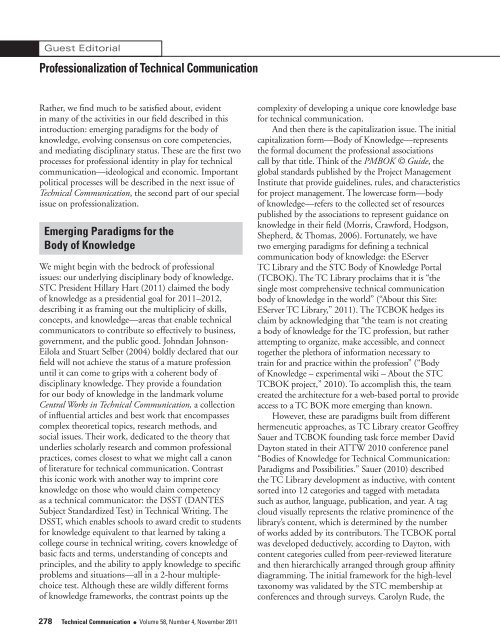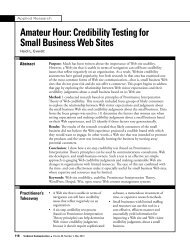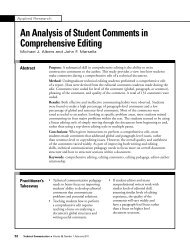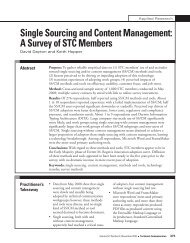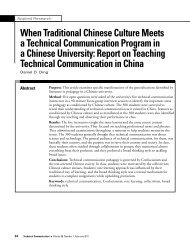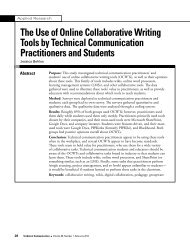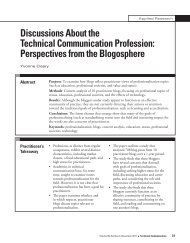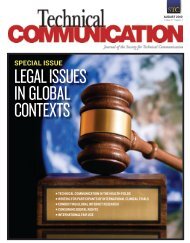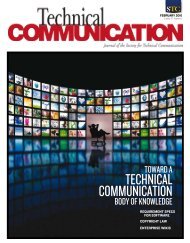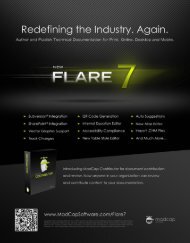SPECIAL ISSUE
Download: November 2011 - Technical Communication - Society for ...
Download: November 2011 - Technical Communication - Society for ...
- No tags were found...
You also want an ePaper? Increase the reach of your titles
YUMPU automatically turns print PDFs into web optimized ePapers that Google loves.
Guest EditorialProfessionalization of Technical CommunicationRather, we find much to be satisfied about, evidentin many of the activities in our field described in thisintroduction: emerging paradigms for the body ofknowledge, evolving consensus on core competencies,and mediating disciplinary status. These are the first twoprocesses for professional identity in play for technicalcommunication—ideological and economic. Importantpolitical processes will be described in the next issue ofTechnical Communication, the second part of our specialissue on professionalization.Emerging Paradigms for theBody of KnowledgeWe might begin with the bedrock of professionalissues: our underlying disciplinary body of knowledge.STC President Hillary Hart (2011) claimed the bodyof knowledge as a presidential goal for 2011–2012,describing it as framing out the multiplicity of skills,concepts, and knowledge—areas that enable technicalcommunicators to contribute so effectively to business,government, and the public good. Johndan Johnson-Eilola and Stuart Selber (2004) boldly declared that ourfield will not achieve the status of a mature professionuntil it can come to grips with a coherent body ofdisciplinary knowledge. They provide a foundationfor our body of knowledge in the landmark volumeCentral Works in Technical Communication, a collectionof influential articles and best work that encompassescomplex theoretical topics, research methods, andsocial issues. Their work, dedicated to the theory thatunderlies scholarly research and common professionalpractices, comes closest to what we might call a canonof literature for technical communication. Contrastthis iconic work with another way to imprint coreknowledge on those who would claim competencyas a technical communicator: the DSST (DANTESSubject Standardized Test) in Technical Writing. TheDSST, which enables schools to award credit to studentsfor knowledge equivalent to that learned by taking acollege course in technical writing, covers knowledge ofbasic facts and terms, understanding of concepts andprinciples, and the ability to apply knowledge to specificproblems and situations—all in a 2-hour multiplechoicetest. Although these are wildly different formsof knowledge frameworks, the contrast points up thecomplexity of developing a unique core knowledge basefor technical communication.And then there is the capitalization issue. The initialcapitalization form—Body of Knowledge—representsthe formal document the professional associationscall by that title. Think of the PMBOK © Guide, theglobal standards published by the Project ManagementInstitute that provide guidelines, rules, and characteristicsfor project management. The lowercase form—bodyof knowledge—refers to the collected set of resourcespublished by the associations to represent guidance onknowledge in their field (Morris, Crawford, Hodgson,Shepherd, & Thomas, 2006). Fortunately, we havetwo emerging paradigms for defining a technicalcommunication body of knowledge: the EServerTC Library and the STC Body of Knowledge Portal(TCBOK). The TC Library proclaims that it is “thesingle most comprehensive technical communicationbody of knowledge in the world” (“About this Site:EServer TC Library,” 2011). The TCBOK hedges itsclaim by acknowledging that “the team is not creatinga body of knowledge for the TC profession, but ratherattempting to organize, make accessible, and connecttogether the plethora of information necessary totrain for and practice within the profession” (“Bodyof Knowledge – experimental wiki – About the STCTCBOK project,” 2010). To accomplish this, the teamcreated the architecture for a web-based portal to provideaccess to a TC BOK more emerging than known.However, these are paradigms built from differenthermeneutic approaches, as TC Library creator GeoffreySauer and TCBOK founding task force member DavidDayton stated in their ATTW 2010 conference panel“Bodies of Knowledge for Technical Communication:Paradigms and Possibilities.” Sauer (2010) describedthe TC Library development as inductive, with contentsorted into 12 categories and tagged with metadatasuch as author, language, publication, and year. A tagcloud visually represents the relative prominence of thelibrary’s content, which is determined by the numberof works added by its contributors. The TCBOK portalwas developed deductively, according to Dayton, withcontent categories culled from peer-reviewed literatureand then hierarchically arranged through group affinitydiagramming. The initial framework for the high-leveltaxonomy was validated by the STC membership atconferences and through surveys. Carolyn Rude, the278 Technical Communication l Volume 58, Number 4, November 2011


